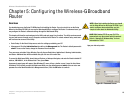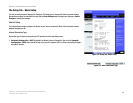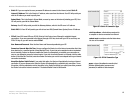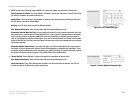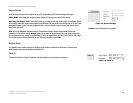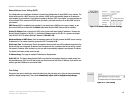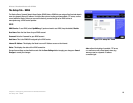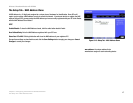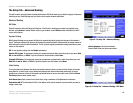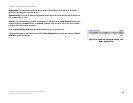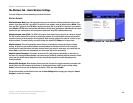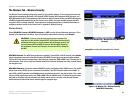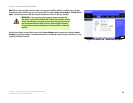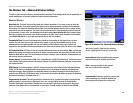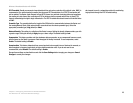
18
Chapter 5: Configuring the Wireless-G Broadband Router
The Setup Tab - Advanced Routing
Wireless-G Broadband Router with SRX200
The Setup Tab - Advanced Routing
This tab is used to set up the Router’s advanced functions. NAT Mode allows you to select the type(s) of advanced
functions you use. Static Routing sets up a fixed route to another network destination.
Advanced Routing
NAT Mode
Select the mode in which this Router will function. If this Router is hosting your network’s connection to the
Internet, select Enable. If another Router exists on your network, select Disable, which will disable the DHCP
server on this Router.
Dynamic Routing
With Dynamic Routing you can enable the Router to automatically adjust to physical changes in the network’s
layout. The Router, using the RIP protocol, determines the network packets’ route based on the fewest number of
hops between the source and the destination. The RIP protocol regularly broadcasts routing information to other
routers on the network.
RIP. To use dynamic routing, click the Enable radio button.
Receive RIP Version. To use dynamic routing for reception of network data, select the protocol you want: Both
RIP v1 and v2, RIPv1, or RIPv2. If you do not want to use this feature, select None.
Transmit RIP Version. To use dynamic routing for transmission of network data, select the protocol you want:
Both RIP v1 and v2, RIPv1, or RIPv2. If you do not want to use this feature, select None.
Static Routing
To set up a static route between the Router and another network, select a number from the Select set number
drop-down list. (A static route is a pre-determined pathway that network information must travel to reach a
specific host or network.) Enter the information described below to set up a new static route. (Click the Delete
This Entry button to delete a static route.)
Enter Route Name. Enter a name for the Route here, using a maximum of 25 alphanumeric characters.
Destination LAN IP. The Destination LAN IP is the address of the remote network or host to which you want to
assign a static route.
Figure 5-14: Setup Tab - Advanced Routing
default gateway: a device that forwards
Internet traffic from your local area network
Figure 5-15: Setup Tab - Advanced Routing - NAT Mode



